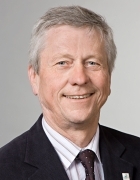
Prof. Dr.-Ing. Horst Baier
Academic Career and Research Areas
Prof. Baier’s (b. 1950) research activities cover fiber composite and material hybrid structures, adaptive/controlled structures (including those with large form variations) and large membrane and aerospace structures. He has also researched processes and algorithms for multidisciplinary design optimization including aeroelasticity and vibroacoustics, as a methodological framework. In addition to computer-aided simulation and optimization, his work involves developing lab models and performing a wide variety of mechanical and environmental tests (e.g. cryogenic and high temperatures).
After studying mechanical engineering at TU Darmstadt, he completed a research fellowship and a doctorate in multidisciplinary structure optimization. Prof. Baier worked for Dornier System in Friedrichshafen (now EADS-Astrium) between 1977 and 1997, focusing on the various technology aspects of mechanical systems. His roles included Senior Head of Department and latterly Chief Engineer. Prof. Baier has been a full professor at TUM since 1997.
Key Publications (all publications)
Rapp S, Kang L, Han J, Müller U, Baier H: „Deformation field estimation for a 2-dimensional structure using fiber bragg grating sensors“. Smart Materials and structures. 2009; 18(2).
AbstractHuber M, Petersson Ö, Baier H: “Knowledge-Based Modeling of Manufacturing Aspects in Structural Optimization Problems”. Advanced Materials Research. 2008; 43: 111-112.
AbstractBaier H, Huber M, Langer H: „Design optimization of hybrid material structures“. International Journal for Structural and Multidisciplinary Optimization. 2008; 10: 1007.
AbstractDatashvili L, Baier H, Encinar J, Legay H: „Mechanical Investigation of a Multi-Layer Reflectarray for Ku-Band Space Antennas”. Journal Aerospace Science and Technology. 2006; 10: 618-627.
AbstractBaier H, Huber M, Raffaellli L: „Modellbasierte Optimierung und experimentelle Charakterisierung der Thermo- und Kryo-Mechanik werkstoffhybrider Bauteile“. Materialwissenschaft und Werkstofftechnik. 2005; 36(6): 248-253.
AbstractIf you wish your profile to be changed or updated please contact Franz Langer.